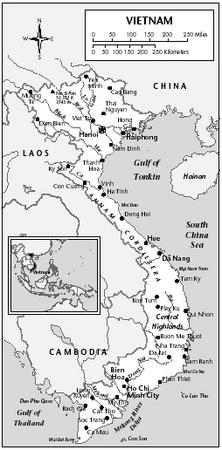Vietnam - Transportation
The war wreaked massive damage on Vietnam's transportation network, especially its railways, roads, and bridges. Further

damage occurred during the Chinese invasion in 1979, after which direct rail and air connections with China were severed. The nation's truck fleet is ancient and seriously lacking in spare parts. Most goods move by small barges or sampans along the countless waterways. The length of inland navigable waterways totals about 17,702 km (11,000 mi), of which 29% is navigable year-round by vessels with less than a 1.8 m draft. Major ports such as Haiphong in the north and Da Nang in the south, are frequently clogged with goods because many of the stevedores—often overseas Chinese—have fled abroad. In 2002, Vietnam had a merchant fleet of 153 ships totaling 527,920 GRT.
Recognizing its importance to economic growth, the government is making a major effort to improve the transportation network. The railroads are to be expanded. There were 3,142 km (1,952 mi) of operable track in 2002. There were 34 airports, 17 with permanent-surface runways in 2001. The nation's air fleet remains primitive, as the national airline (Hang Khong Vietnam) uses Soviet passenger liners built in the 1950s. In 2001, 3,410,300 passengers were carried on scheduled domestic and international flights. There were 93,300 km (57,977 mi) of roads in the country in 2001, but only 23,418 km (14,552 mi) were paved. There were an estimated 93,600 cars and several million motorcycles in 2000. The main route from Hanoi to Ho Chi Minh City badly needs improvement. In 1997, the government authorized the construction of a new north-south highway, the largest infrastructural project ever undertaken in Vietnam. The construction will take at least fifteen years, utilizing ten days of mandatory labor from almost every citizen between the ages of 18 and 45.
Comment about this article, ask questions, or add new information about this topic: